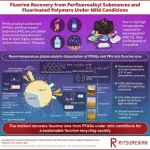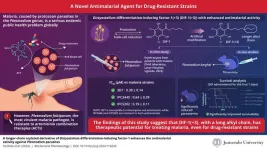(Press-News.org) The Howard Hughes Medical Institute announced on July 23, 2024 that 26 of the nation’s leading scientists have been named HHMI Investigators.
Paving the way for new scientific and biomedical discoveries in fields ranging from neuroscience to immunology to structural biology, these scientists come from 19 US institutions and join HHMI’s current Investigator community, comprising more than 250 scientists.
HHMI will invest more than $300 million in this newest cohort over the next seven years, enabling each Investigator to push the boundaries of science.
“HHMI is committed to supporting visionary scientists who are pursuing discoveries that will change our world for the better,” says HHMI Vice President and Chief Scientific Officer Leslie Vosshall.
Guided by the principle of investing in “people, not projects,” HHMI provides Investigators with the time and resources they need to go where their science leads, Vosshall says. Each new HHMI Investigator will receive roughly $11 million in support over a seven-year term, which is renewable indefinitely pending a successful scientific review. This support includes their full salary and benefits, a generous research budget, scientific equipment, and additional resources.
HHMI selects Investigators through a national open competition, which includes evaluation by an advisory panel of leading scientists as well as HHMI scientific leadership. Nearly 1,000 eligible scientists submitted applications during the competition. This year’s evaluation included a focus on research culture and mentoring, and highlighted individuals’ efforts to make science open and accessible to all.
“When scientists create environments in which others can thrive, we all benefit,” says HHMI President Erin O’Shea. “These newest HHMI Investigators are extraordinary, not only because of their outstanding research endeavors but also because they mentor and empower the next generation of scientists to work alongside them at the cutting edge.”
To date, 34 current or former HHMI scientists have won the Nobel Prize – most recently, Carolyn Bertozzi in 2022 for the development of click chemistry and bioorthogonal chemistry. HHMI Investigators have long made significant contributions across many research areas, including biochemistry, molecular biology, plant sciences, cancer biology, cell biology and many other scientific disciplines.
Below are the 26 new HHMI Investigators:
• Jonathan Abraham, MD, PhD (Harvard University)
• Dmitriy Aronov, PhD (Columbia University)
• Janelle Ayres, PhD (Salk Institute for Biological Studies)
• Siobhán M. Brady, PhD (University of California, Davis)
• Edward Chouchani, PhD (Dana-Farber Cancer Institute)
• James J. Collins III, PhD (The University of Texas Southwestern Medical Center)
• José R. Dinneny, PhD (Stanford University)
• Steve Flavell, PhD (Massachusetts Institute of Technology)
• Lillian Fritz-Laylin, PhD (University of Massachusetts Amherst)
• Mary Gehring, PhD (Whitehead Institute for Biomedical Research)
• Lisa Giocomo, PhD (Stanford University)
• Viviana Gradinaru, PhD (California Institute of Technology)
• Valentina Greco, PhD (Yale University)
• André Hoelz, PhD (California Institute of Technology)
• Mehrdad Jazayeri, PhD (Massachusetts Institute of Technology)
• Gene-Wei Li, PhD (Massachusetts Institute of Technology)
• Steven McCarroll, PhD (Harvard University)
• Dave Pagliarini, PhD (Washington University in St. Louis)
• Carrie Partch, PhD (University of California, Santa Cruz)
• Vijay G. Sankaran, MD, PhD (Boston Children’s Hospital)
• Sichen (Susan) Shao, PhD (Harvard University)
• Samuel H. Sternberg, PhD (Columbia University)
• Gabriel D. Victora, PhD (The Rockefeller University)
• Ilana B. Witten, PhD (Princeton University)
• Michael Yartsev, PhD (University of California, Berkeley)
• Li Ye, PhD (Scripps Research Institute)
More information about HHMI’s Investigator Program can be found online at hhmi.org.
###
HHMI is the largest private biomedical research institution in the nation. Our scientists make discoveries that advance human health and our fundamental understanding of biology. We also invest in transforming science education into a creative, inclusive endeavor that reflects the excitement of research. HHMI’s headquarters are located in Chevy Chase, Maryland, just outside Washington, DC.
END
High blood pressure is known to increase a person’s chances of having a stroke.
But a study led by Michigan Medicine narrows in on the cumulative effects of years of high systolic blood pressure — the top number on the blood pressure reading and how hard the heart pumps blood to the arteries — finding that a higher average reading during adulthood is linked with a greater risk for the two most common types of stroke.
The study, published in JAMA Network Open, analyzed the average systolic blood pressure years ahead of the first stroke for more than 40,000 people ...
IMDEA Software researchers Facundo Molina, Juan Manuel Copia and Alessandra Gorla present FIXCHECK, a novel approach to improve patch fix analysis that combines static analysis, randomized testing and large language models. Their innovations, embodied in the paper: "Improving Patch Correctness Analysis via Random Testing and Large Language Models" were presented at the International Conference on Software Testing, Verification and Validation (ICST 2024).
Context
Generating patches that fix software defects is a crucial task in the maintenance of software systems. Typically, software ...
A study of volatile organic compounds (VOCs) emitted by new cars on hot summer days finds concerning levels of formaldehyde and other aldehydes. Consumers are familiar with—and even drawn to—the “new car smell” produced as VOCs from carpets, upholstery, and other interior materials in newly manufactured passenger vehicles. These VOCs can cause a range of health effects, including headaches, inflammation of the eyes, nose and throat, fatigue, irritability, dry cough, lung disease, and disorientation. Jianyin Xiong, Shaodan Huang, and colleagues sought to capture the levels of VOCs in the passenger cabins of new cars on ...
Perfluoroalkyl substances (PFASs), nicknamed ‘forever chemicals,’ pose a growing environmental and health threat. Since the invention of Teflon in 1938, PFASs and perfluorinated polymers or PFs have been widely used for their exceptional stability and resistance to water and heat. These properties made them ideal for countless applications, from cookware and clothing to firefighting foam. However, this very stability has become a major problem. PFASs do not easily break down in the environment, leading ...
Malaria remains a serious health issue globally, especially in Africa. The disease is caused by protozoan parasites in the Plasmodium genus. In 2021, there were 247 million cases of malaria and 619,000 deaths reported worldwide. At present, the first line of treatment against malaria is artemisinin combination therapy (ACT) and the administration of artemisinin derivatives in combination with other drugs. After the introduction of ACTs in Africa, which accounts for more than 90% of the world’s malaria cases, the number of deaths due to malaria greatly declined in the mid-2000s. However, Plasmodium falciparum, the most virulent malaria parasite, is resistant to ACT and has been spreading ...
Nearly four decades ago, Boston College quarterback Doug Flutie launched a game-winning, mid-field touchdown pass to upset the University of Miami on the game’s final play—prompting a subsequent surge in applications to the school in what has been dubbed the “Flutie Effect.”
A team of NYU researchers has now found evidence of this effect beyond the gridiron—and athletic competition. During and after Morocco’s surprising run to the World Cup semi-finals in the fall 2022, online searches on non-sports topics related to Morocco increased ...
Data from the Anti-Amyloid Treatment in Asymptomatic Alzheimer’s (A4) study, the first and largest clinical trial of pre-symptomatic Alzheimer’s disease, is now widely available to researchers studying the condition. The comprehensive dataset has already yielded key insights about Alzheimer’s disease, which affects nearly seven million people in the United States, and sharing the data opens avenues for further progress.
A4 researchers screened more than 7,500 people and enrolled 1,169 people with pre-symptomatic Alzheimer’s disease. This stage ...
Scientists have succeeded in pinpointing the neurons within a female fruit fly’s brain that respond to signals from the male during mating.
Male fruit flies transfer a substance called a sex-peptide during mating in the seminal fluid together with sperm. This sex pheromone influences the female fly’s behaviour so she will start to lay eggs and be less inclined to mate further.
This is a common phenomenon in insects but until now, it was not known where in the nervous system the neurons are located that direct ...
Researchers at the National Institutes of Health (NIH) found that an artificial intelligence (AI) model solved medical quiz questions—designed to test health professionals’ ability to diagnose patients based on clinical images and a brief text summary—with high accuracy. However, physician-graders found the AI model made mistakes when describing images and explaining how its decision-making led to the correct answer. The findings, which shed light on AI’s potential in the clinical setting, were published in npj ...
DURHAM, N.C. -- Medications used by astronauts on the International Space Station might not be good enough for a three-year journey to Mars.
A new study led by Duke Health shows that over half of the medicines stocked in space -- staples such as pain relievers, antibiotics, allergy medicines, and sleep aids -- would expire before astronauts could return to Earth.
Astronauts could end up relying on ineffective or even harmful drugs, according to the study appearing July 23 in npj Microgravity, a Nature journal.
“It doesn’t necessarily mean ...


